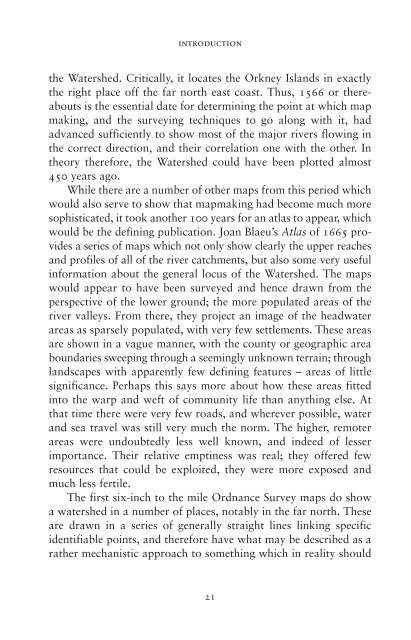Ribbon of Wilderness by Peter Wright sampler
If you’ve bagged the Munros, done the Caledonian Challenge and walked the West Highland Way, this is your next conquest. The Watershed of Scotland is a line that separates east from west; that divides those river basin areas which drain towards the North Sea from those which flow west into the Atlantic Ocean on the other. It’s a line that meanders from Peel Fell on the English border all the way to the top at Duncansby Head, near John O’ Groats – over 745 miles, through almost every kind of terrain. The Watershed follows the high ground, and offers wide vistas down major river valleys, towards towns and communities, into the heartlands of Scotland. Walk the Watershed in eight weeks Tackle short sections over a weekend 7 route maps Over 30 colour photographs Ribbon of Wildness provides a vivid introduction to this geographic and landscape feature, which has hitherto been largely unknown. The rock, bog, forest, moor and mountain are all testament to the Watershed’s richly varied natural state. The evolving kaleidoscope of changing vistas, wide panoramas, ever-present wildlife, and the vagaries of the weather, are delightfully described on this great journey of discovery.
If you’ve bagged the Munros, done the Caledonian Challenge and walked the West Highland Way, this is your next conquest.
The Watershed of Scotland is a line that separates east from west; that divides those river basin areas which drain towards the North Sea from those which flow west into the Atlantic Ocean on the other. It’s a line that meanders from Peel Fell on the English border all the way to the top at Duncansby Head, near John O’ Groats – over 745 miles, through almost every kind of terrain. The Watershed follows the high ground, and offers wide vistas down major river valleys, towards towns and communities, into the heartlands of Scotland.
Walk the Watershed in eight weeks
Tackle short sections over a weekend
7 route maps
Over 30 colour photographs
Ribbon of Wildness provides a vivid introduction to this geographic and landscape feature, which has hitherto been largely unknown. The rock, bog, forest, moor and mountain are all testament to the Watershed’s richly varied natural state. The evolving kaleidoscope of changing vistas, wide panoramas, ever-present wildlife, and the vagaries of the weather, are delightfully described on this great journey of discovery.
Create successful ePaper yourself
Turn your PDF publications into a flip-book with our unique Google optimized e-Paper software.
<strong>Ribbon</strong>s <strong>of</strong> Wildness_2016_Layout 1 24/05/2016 19:26 Page 21<br />
introduction<br />
the Watershed. Critically, it locates the Orkney Islands in exactly<br />
the right place <strong>of</strong>f the far north east coast. Thus, 1566 or there -<br />
abouts is the essential date for determining the point at which map<br />
making, and the surveying techniques to go along with it, had<br />
advanced sufficiently to show most <strong>of</strong> the major rivers flowing in<br />
the correct direction, and their correlation one with the other. In<br />
theory therefore, the Watershed could have been plotted almost<br />
450 years ago.<br />
While there are a number <strong>of</strong> other maps from this period which<br />
would also serve to show that mapmaking had become much more<br />
sophisticated, it took another 100 years for an atlas to appear, which<br />
would be the defining publication. Joan Blaeu’s Atlas <strong>of</strong> 1665 pro -<br />
vides a series <strong>of</strong> maps which not only show clearly the upper reaches<br />
and pr<strong>of</strong>iles <strong>of</strong> all <strong>of</strong> the river catchments, but also some very useful<br />
information about the general locus <strong>of</strong> the Watershed. The maps<br />
would appear to have been surveyed and hence drawn from the<br />
perspective <strong>of</strong> the lower ground; the more populated areas <strong>of</strong> the<br />
river valleys. From there, they project an image <strong>of</strong> the headwater<br />
areas as sparsely populated, with very few settlements. These areas<br />
are shown in a vague manner, with the county or geographic area<br />
boundaries sweeping through a seemingly unknown terrain; through<br />
landscapes with apparently few defining features – areas <strong>of</strong> little<br />
significance. Perhaps this says more about how these areas fitted<br />
into the warp and weft <strong>of</strong> community life than anything else. At<br />
that time there were very few roads, and wherever possible, water<br />
and sea travel was still very much the norm. The higher, remoter<br />
areas were undoubtedly less well known, and indeed <strong>of</strong> lesser<br />
importance. Their relative emptiness was real; they <strong>of</strong>fered few<br />
resources that could be exploited, they were more exposed and<br />
much less fertile.<br />
The first six-inch to the mile Ordnance Survey maps do show<br />
a watershed in a number <strong>of</strong> places, notably in the far north. These<br />
are drawn in a series <strong>of</strong> generally straight lines linking specific<br />
identifiable points, and therefore have what may be described as a<br />
rather mechanistic approach to something which in reality should<br />
21


















